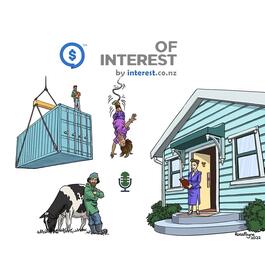
Imre Speizer: What to expect from interest rates and the NZ dollar over coming months
With US Federal Reserve Chairman Jerome Powell signalling interest rate cuts ahead, the US dollar's likely to weaken with the Kiwi dollar rising against it, Imre Speizer, Head of NZ Markets Strategy at Westpac Institutional Bank, says. Speaking in a new episode of the Of Interest podcast, Speizer says although the expected central bank interest rate trajectory is very similar in NZ and the US over the next 12 months, financial markets will focus much more on the US. "If the two racehorses go neck and neck, that should probably be neutral for the Kiwi dollar. [But] I don't think it will be, because the market will put a lot more importance on the US side of things. So even though the yield spread between New Zealand rates and US rates might not move too much, just the fact that the Fed is cutting aggressively will actually weigh on the broader US dollar," Speizer says. "So you'll get the market selling the US dollar against all of the major G10 currencies and that will have a ripple effect into the Kiwi-US exchange rate... And therefore, if we see that US dollar weakening, which is our view over the next few quarters, you should see the Kiwi-US, all things equal, rising a bit." Speizer also expects local swap rates, already down significantly over the last couple of months, to continue falling. "The swap rates are going to fall a bit further over the next few quarters, and that's simply mechanical. So even if views around the economy don't change, the markets have already priced in this whole easing cycle. So think of it as they're priced in, they know the Official Cash Rate is 5.25% today. They believe it'll be below 5% by the end of the year. And in a year's time, into the threes [3% range], that's already priced in," Speizer says. "So as you move forward in time, those high OCRs drop out of the calculation of a swap rate and you just mechanically end up with a lower rate. So even if nothing in the world changed, you would see, for example, that two year swap rate moving from its current rate of about 3.85% down towards somewhere in the lower threes over time. So that's just time and the mathematics doing its work. It's not really the market moving as such." "Swap rates are very important in the New Zealand financial markets. They're arguably the most important interest rate instrument. Whatever swap rates do, other interest rates will follow. So, for example, if your two year swap rate went up by 100 basis points, you would find mortgage rates following suit, other business lending rates, bond yields, pretty much anything. They are the foundation of all interest rates in New Zealand. And the swap rates themselves are constructed by expectations of the OCR mostly," says Speizer. In the podcast audio he also talks about what in Powell's Jackson Hole comments surprised financial markets, what to watch ahead of September's Federal Open Markets Committee meeting, OCR market expectations, what the yield curve is telling us at the moment, how commodities might start to exert more influence on exchange rates, the NZ government bond market following the issuing last week of a $6 billion bond that attracted record interest of $22.7 billion, the yen carry trade, Australia, China, geopolitical risk, and where he sees the NZ dollar at year's end.
From "Of Interest"


Comments
Add comment Feedback